FILTER PLAYOFF OBSERVATIONS
Summary
of Results
Observations were
made of CoRoT-3 on 2009.09.14 using filters CBB, NIR, V, Rc and i’ rotated
into place in alternation. Exposure times were set in a way that led to
similar total flux (and SNR) for the target for each filter. A standard
procedure was used for image processing and spreadsheet light curve optimization
for each filter. Since for this 5-hour observing session there was no transit
the data were fitted using a simple model with three free parameters (offset,
slope and air mass curvature). RMS departure from the best model fit was
used to assess measurement quality. Since exposure times ranged from 5 seconds
to 32 seconds a “figure of merit” was calculated that endeavors to predict
the RMS quality of what would have been measured if each filter were used
exclusively during the observing session. The figure of merit is proportional
to “information rate” (proportional to the inverse square-root of the predicted
RMS off a model light curve) using exposure times of 48 seconds and download
and settle times totaling 12 seconds (which are typical observing settings
for amateur telescopes observing typical exoplanet stars). Such a figure
of merit can be described as the speed with which a specific precision can
be achieved. The results of these calculations show the following “speed for
reaching a precision goal”, presented in order of the fastest (and normalized
to the slowest filter): CBB (6.3), Rc (2.9), NIR (1.7), i’ (1.3) and V (1.0). For this observing situation the CBB filter was about 6
times better than the V-band filter. Since CoRoT-3 is fainter than the typical
exoplanet star the same set of 500 images was re-processed with a brighter
star assigned to the role of exoplanet. For a “make believe” exoplanet star
with V = 11.7, similar to the median for the list of 46 BTEs, the following
figure of merits were determined: CBB (8.1), NIR (5.4), Rc (5.1), I’ (4.6) and V (1.). When an even brighter
star was assigned the exoplanet star role (V = 10.2) the results were essentially
the same: i’ (8.1), NIR (6.8), CBB (6.2), Rc (5.4)
and V (1.0).
Introduction
The observations
reported here were designed to determine which filter produces the best quality
light curves for typical exoplanet observing conditions using amateur hardware
and software. I use my Celestron 11-inch (CPC 1100) telescope with a focal
reducer placed in front of the CFW/CCD. The CCD is a SBIG ST-8XE (KAF 1602E
chip). Autoguiding is performed using the second CCD chip. The CFW contains
the following filters, all of which are used in this evaluation: CBB, NIR,
V, Rc and i’ (where CBB is a clear filter with blue blocking at ~ 480 nm,
NIR is a long pass filter with turn-on at 710 nm, V is Johnson V-band, Rc
is a Cousins R-band and i’ is SDSS i-band). Although additional observing
sessions may be used to verify the results reported here the following description
of the first observing session, on 2009.09.14, shall serve to illustrate
the protocol and analysis procedures for all of them.
Observation Protocol
The observing session
was 4 hours long (after which the dome’s low-elevation opening obstructed
observations). Observations started at air mass 1.2 and data for air mass
> 4.5 were not used. CoRoT-3 was observed under out-of-transit conditions.
This enabled the measured magnitudes to be fitted using a simple light curve
(LC) model with only three free parameters (offset, slope and air mass curvature).
It was decided to employ exposure times that produced approximately the same
flux for the target star (CoROT-3) for each filter (Arne’s suggestion). This
led to greatly different exposure times due to the large range of filter
throughputs. Filter throughputs for all the filters I use are listed in the
following table, and the exposure times used for this “filter playoff” observing
session are included. For the chosen exposure times the star fluxes for the
target were approximately the same and so were the SNR’s
(although SNRs should differ because sky background
levels differ with wavelength).
Filter
Throughput (at airmass 1.2) and Exposure Times
CLR 100%
CBB 92% 5 sec
NIR 37% 16 sec
B 6%
V 19% 32 sec
R 36% 14 sec
I 22%
g’ 26%
r’ 48%
i’ 37% 16 sec
z’ 9%
Images were made
in the following sequence: NIR, V, Rc, i’ and
CBB. Exactly 100 cycles of this sequence were made (prior to the dome obstruction
problem), so there are 100 images with each of these 5 filters. Autoguiding
was used to maintain the star field fixed to the CCD pixel field (although
some wander did occur). Master flats were made on the same night of these
observations for each filter using the twilight sky (and a diffuser over
the telescope aperture). A master dark frame was made at the end of the target
observations (at the same CCD temperature as the target observations). A
bias frame was used from a previous observing session. Focus settings were
automatically adjusted to compensate for telescope tube temperature changes.
Measures were taken so that all images had the same sharpness (FWHM typically
4.5 pixels). All observing was controlled by MaxIm
DL (MDL).
MDL was also used
for image calibration and measurement. Calibration consisted of bias, dark
and flat field corrections. Hot pixels were removed from each image (25%
was determined to be “safe” because it didn’t change a star’s maximum count
for many tests of sharp images). Star alignment was made for all images for
a filter group. MDL was then used to perform photometric measurements of the
target star (CoRoT-3), the artificial star (flux the same for all images)
and 27 nearby bright (unsaturated) stars. CSV files were recorded for measurements
made with a selection of photometry aperture radii. It is well known that
the optimum aperture size depends on SNR. Faint asteroids provide the best
rotation LCs for a photometry aperture radius,
r, of about 1.4 x FWHM. Bright stars produce the best LCs for r about 3 x FWHM. CoRoT-3 is of intermediate
brightness for the present choice of exposure times (SNR ~ 40) so the range
of photometry apertures employed was from ~1.8 to 3 x FWHM.
A spreadsheet was
used for the rest of the analysis. Star magnitudes were converted to flux,
and these were added for all 27 non-target stars in order to solve for atmospheric
extinction. It was found that extinction ranged from 0.065 mag/airmass (NIR) to 0.160 mag/airmass
(V-band). A search was made for which subset of the 27 stars provided the
lowest RMS noise for the target. This RMS noise was calculated by comparing
each target star magnitude with the median of its 8 closest neighbors, and
a standard deviation of all such differences (with a small correction for
the fact that 8 isn’t infinity) was used to establish an RMS for the observing
session. The next step was to model-fit the target magnitudes using as a
criterion the lowest RMS deviation from the model, RMSmodel.
When a good model fit was found a search was made of reference star sub-sets
that produced the lowest RMS deviation from the model. This step usually
did not lead to many changes in reference star selection (change would occur
if systematic effects differed among the 27 candidate reference stars). If
a large improvement in fitting the model was achieved by changing the reference
star sub-set then another iteration was performed:
model fit for minimum RMSmodel, search for a
better reference star subset (that reduces RMSmodel).
It is rare to have to iterate like this more than once. I view the final
model and reference star subset to be a “global minimum” solution.
Observational Results
The next figure
is a “solution” for CBB.
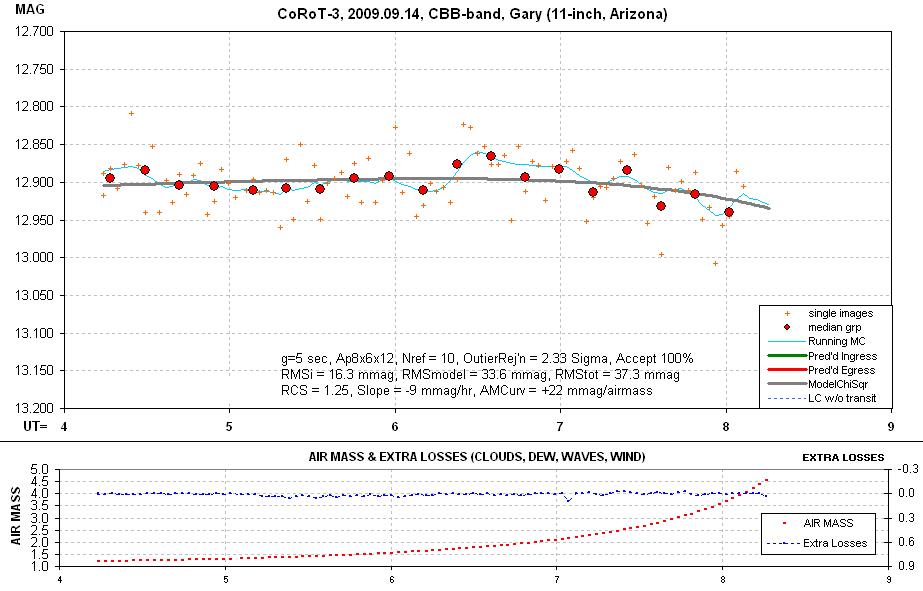
Figure H01. Example of a LC solution. The filter is CBB and exposures were 5 seconds.
The other filters
produced similar looking light curves. The target is bluer than average (B-V
= +0.91), so most of the references stars must be redder. Notice that air
mass exceeds 3.0 during the last 40 minutes, and this, combined with the
difference in color of the target and references stars, must cause the model
fit to require an “air mass curvature” component.
The next table summarizes
the measurements for each filter image set. The first row (below filter names)
is “throughput” – or percentage of light from a typical star that reaches
the CCD when a filter that is in the optical path compared to the amount
of light reaching the CCD when no filter is in place. The second row is the
median FWHM of the images. The third row shows the photometry aperture radius
that produced the best result. By best result is meant the smallest RMS departure
from the LC model fit (where all of the following parameters were optimized:
sub-set of candidate reference stars used for reference and model offset,
slope and airmass curvature).
The next row shows atmospheric extinction. The next row shows RMSi, which is the RMS of measurements with respect
to the median of the 8 nearest neighbors. This noise is for a short timescale,
and if systematics vary slowly they will not affect
RMSi. Next is RMSmodel,
which is the RMS deviation of differences with the best fitting model LC.
This RMS can be thought of as the orthogonal sum of RMSi
and RMSsys (systematics). Therefore, by orthogonally
subtracting RMSi from RMSmodel
we arrive at RMSsys, shown in the next row. Exposure
time, g, is shown in the next row. Info/image is “information per image”,
calculated from the inverse
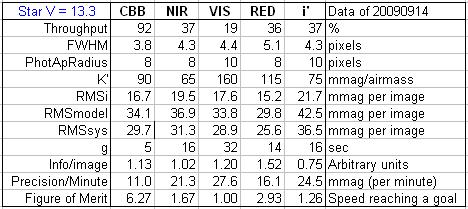
Figure H02. Summary
of filter playoff results for the CoRoT-3 (V = 13.3).
There are some instructive
things to notice about this table. The values of RMSi
should decrease with increasing exposure time, according to 1/sqrt(g), if we’re in the “faint star” domain – where
stochastic noise (thermal, sky background, etc) is dominant. The values for
RMSsys, however, should not change with exposure
time since they are a component of systematics that presumably varies slowly
with time (as the star field slowly moves over the CCD field, for example)
and some components of systematics will be approximately the same for each
filter.
RMSi consists of two
major components: Poisson noise and scintillation noise. It is always interesting
to keep track of the importance of scintillation noise in order to know how
to fine-tune observing strategy. Although the level of scintillation can
change greatly from night to night, or even on hour timescales, it’s worth
asking what a typical scintillation level should be for the observing conditions
of this case study. According to Dravins et
al (1998):
![]()
where sigma is RMS fluctuation (fractional intensity),
D is telescope diameter (cm), sec(Z) is air mass, h is observing site altitude
(meters) and g is exposure time (seconds). All observations reported here
have the same D and h, so this equation becomes:
Sigma [mmag] = 5.8
* AirMass^1.75 / sqrt(g)
The highest scintillation
level is predicted for CBB-band near the end of the observing session; during
the last 40 minutes the scintillation level is predicted to be ~ 23 mmag.
Inspection of the RMSi(t) plot shows an increase at this time, being ~38 mmag
(instead of 32 mmag before then). These two RMSi
values are consistent with the predicted scintillation increase. For the
other filters and exposure
times predicted scintillation was never significant.
It is interesting
to note the relation between “Precision per Minute” and filter throughput.
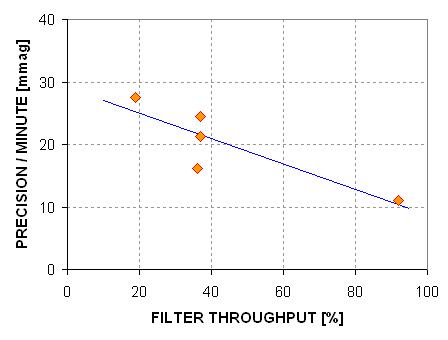
Figure H03. Precision/Minute versus filter throughput (13.3
magnitude star and 11-inch aperture).
The message of this
plot is “The greater the filter throughput the better the precision!” This
may simply be a consequence of observing a faint target (SNR ~ 40 for all
filters). This result suggests that optimum filter choice may depend on target
brightness, and the results so far are what we can expect for the faint regime.
It is therefore not surprising that for this example the Figure of Merit
is correlated with filter throughput. Just because the CBB filter is optimum
for faint exoplanet stars doesn’t mean it will be optimum for bright exoplanet
stars.
Fortunately, the
set of images used in the analysis so far can be used to evaluate Figure
of Merit for a brighter star. This can be done by simply selecting a brighter
star for treatment as the “target.” That’s the goal of the next section.
Average BTE Brightness
Target Star Analysis
The following figure
shows two other stars that can serve as surrogate exoplanet stars in OOT
mode available for use to evaluate Figure of Merit versus star brightness.
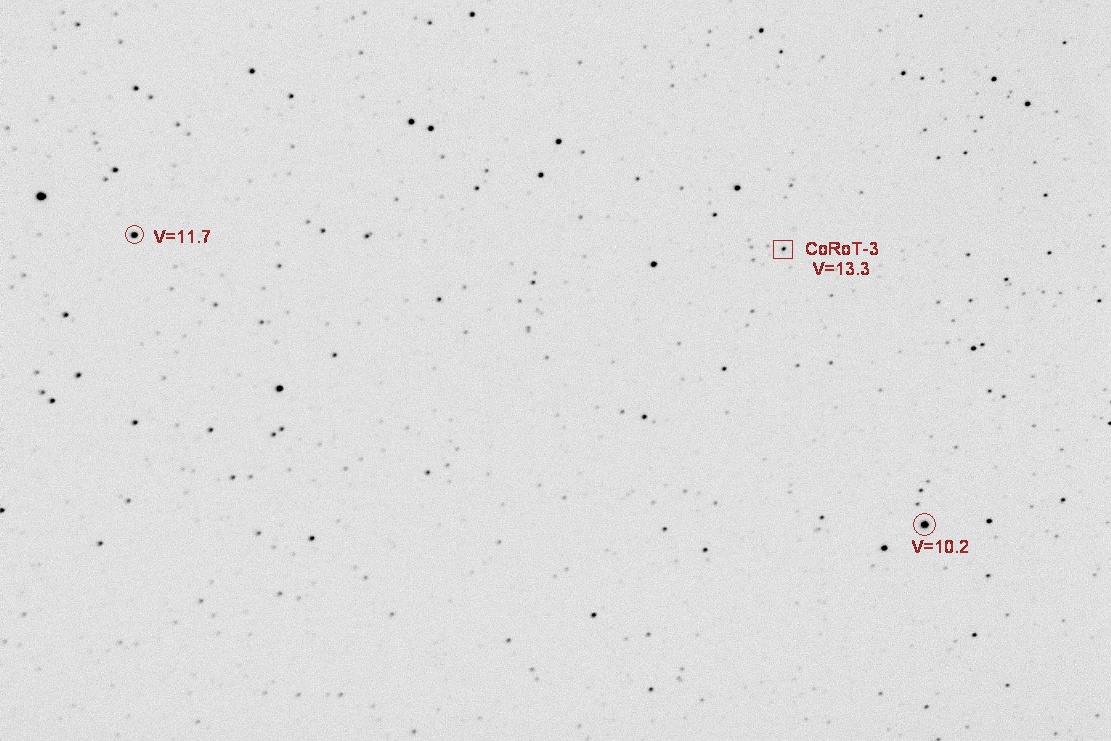
Figure H04. CoRoT-3
FOV, 22x14 ‘arc, showing two stars brighter than CoRoT-3.
The star labeled
V=11.7 is 1.6 magnitudes brighter than CoROT-3 and is also close to the median
brightness of the list of 46 known BTEs. It will be used to determine filter
performance in a way analogous to what was done in the previous section.
The same procedure
used for CoRoT-3 was used with the V-mag = 11.7
star. As expected the LC quality for this brighter
star is better than for the 13.3 magnitude exoplanet star. The next figure
is the LC using the NIR filter.
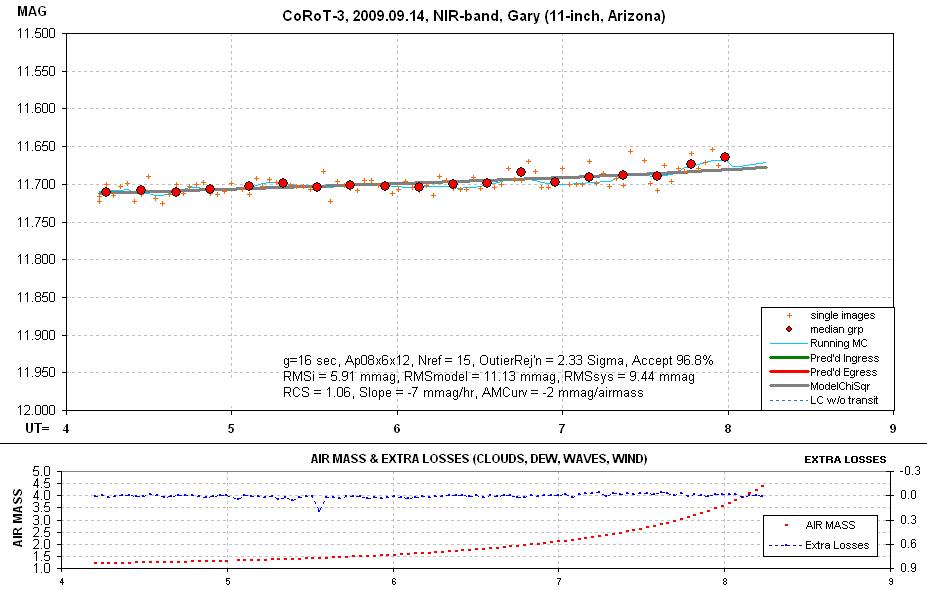
Figure H05.
NIR filter LC for the V-mag
11.7 star.
The following figure
summarizes results for this star for the 5 filters.
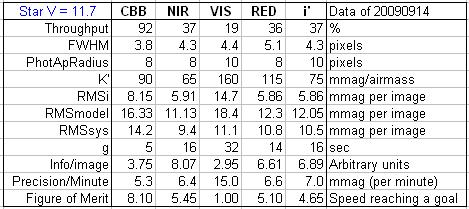
Figure H06. Summary
of observations of a star with V = 11.7, similar to typical BTE.
The highest Figure
of Merit is obtained using the CBB filter, but the NIR, Rc and i’ filters are all a close second. The V-band
filter is the slowest choice for achieving useable LCs.
Precision per Minute
is not as strongly correlated with filter throughput as it is for the fainter
star, as the next figure shows.
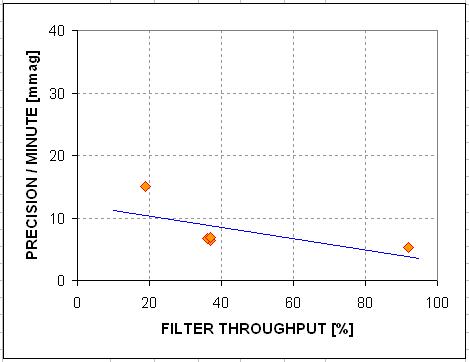
Figure H07. Precision
performance versus filter throughput for the V = 11.7 star.
Scintillation is
predicted to be more important for the brighter star simply because other
stochastic noise levels are lower (whereas scintillation level is the same
for all stars, regardless of their brightness.) The scintillation levels
for each filter will be the same as calculated above, for fainter CoRoT-3.
As stated above, the highest scintillation is expected for the CBB images,
with a low of 3.6 mmag for the first few hours and an average of ~23 mmag
during the last 40 minutes. A plot of RMSi(t) shows a rise
from ~12 mmag during the first few hours to ~25 mmag near the end of the observing
session. This could be explained if scintillation near the end was ~22 mmag,
which is close to what is expected from the Dravins
et al (1998) scintillation model. Scintillation levels for V-band ranged
from 1.4 mmag to 9.2 mmag, and these are small enough to have only small
effects on the observing session averages.
For given levels
of noise and scintillation, if we ignore the effect of duty cycle on exposure
time, longer exposure times don’t reduce the effect of scintillation when
considering “information rate” – or Precision per Minute of observing time.
In other words, the average of 10 short exposures will have the same level
of scintillation noise as one exposure 10 times as long. This concept is
commonly understood for other stochastic noise levels (such as thermal noise,
sky background noise, etc), but when the issue is scintillation there is a
tendency to forget the concept and mistakenly recommend long exposures to
reduce scintillation.
Brighter Than Average
BTE Target Star Analysis
Finally, let’s consider
a star brighter than most exoplanets to see if CBB continues to outperform
the other filters. The V = 10.2 star, shown in Fig.
A04, has been processed using the same procedure
used for the two fainter stars. The LC performances for the i’ and V filters are shown in the next two figures.
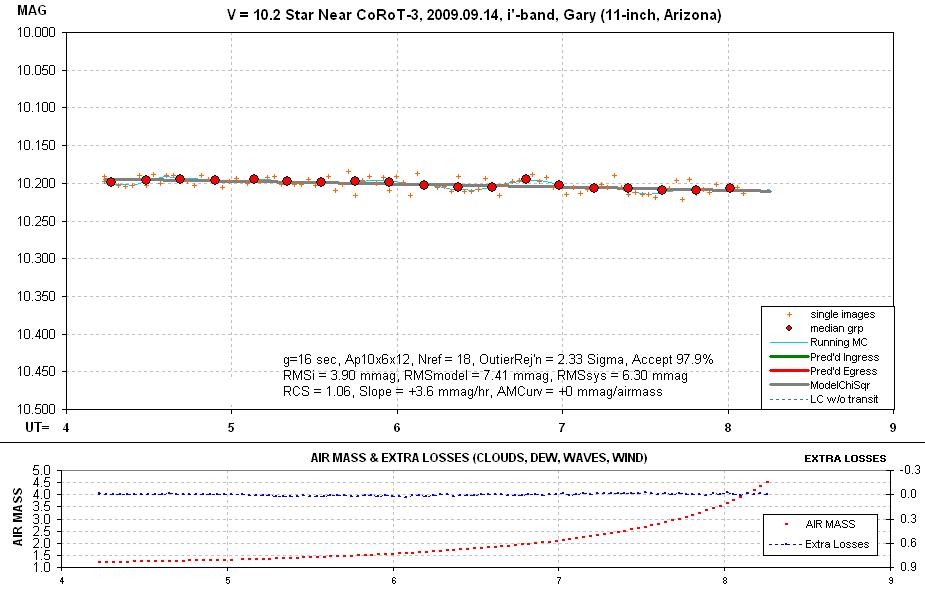
Figure H08. i’-band light curve for the V = 10.2 star.
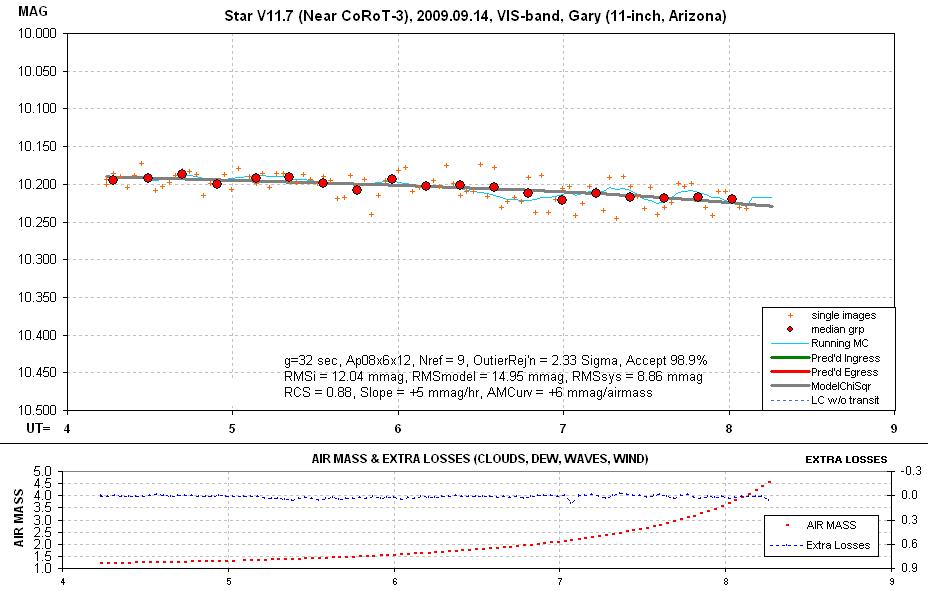
Figure H08.
V-band light curve for the V = 10.2 star.
It’s apparent from
visual inspection that the i’-band light curve
is a better quality one than the V-band light curve. This is also borne out
by the quantitative measurements, shown in Fig. A09.
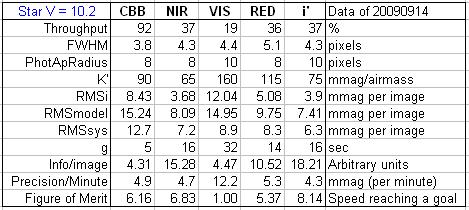
Figure H09. Summary
of observations of a star with V = 10.2, brighter than a typical BTE star.
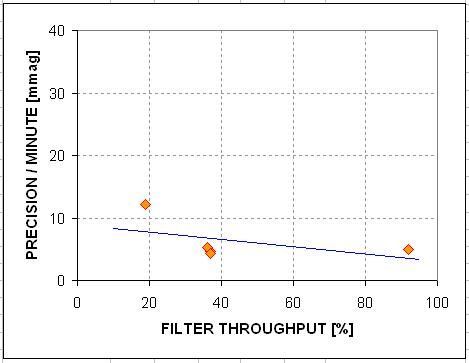
Figure H11. Precision
performance versus filter throughput for the V = 10.2 star.
For stars near the
bright end of those in the BTE list the best filter for light curves is the i’-band filter. It is 8 times faster than the V-band
filter in achieving a specific RMS level of precision. The NIR filter is
almost as good, and the CBB and RED filters are close behind.
Concluding Remarks
The results reported
here suggest that the best overall filter choice for exoplanet light curve
observing is the CBB filter. Brighter exoplanet stars might be observed with
greater precision using an i’-band filter, or
maybe the NIR filter. For stars ranging in brightness from brighter than typical
to the faintest, the worst-performing filter was found to be V-band.
Suppose the amateur community
of exoplanet observers started to switch from V and Rc filters to CBB? Would
science be lost? Let's review a short list of the science that amateur exoplanet
light curves might provide. Transit timing variations (TTV), based on mid-transit
times for transits by many observers, can be used to search for another exoplanet
in a resonant orbit. TTV can also be used to search for evidence of exomoons.
It is my position that compromises to science from using CBB (or NIR) filters
will be not only minimal, but if amateurs switch to CBB and NIR filters
To my knowledge
this is the first report of results from an observing session designed specifically
to identify optimum filter choices for exoplanet light curve observing. There
may be flaws in my procedure, and I am open to comments on an improved observing
protocol or an improved image analysis protocol. I welcome others to conduct
their own “filter playoff” observations, and share them with the community
of amateur exoplanet observers. Until others confirm what I have found it
is fair to characterize my results as merely “suggestive.” The suggestion,
to be explicit, is that the overall best filter choice is CBB-band.
Addendum
The following filter transmission plot shows how the CBB and NIR filters
relate to standard filters.
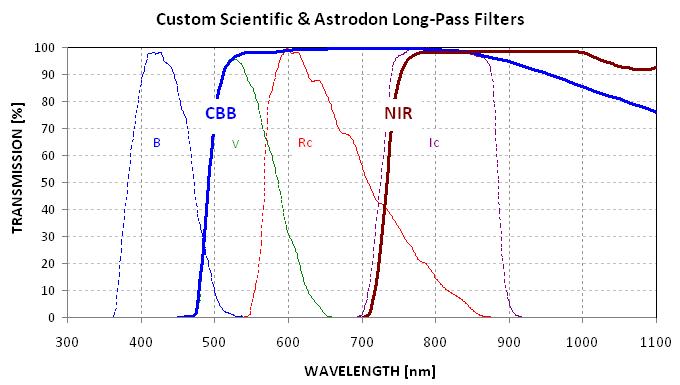
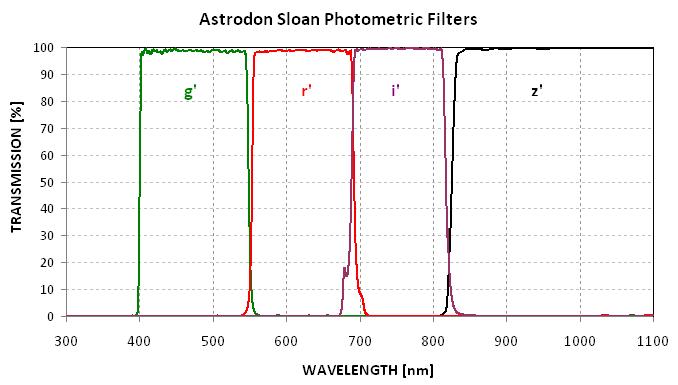
Figure H12. Spectral transmission shapes of the CBB filter (by
Custom Scientific), the NIR, B, V, Rc, Ic and SDSS filters g', r', i' and
z' (by Astrodon). Transmission functions were kindly provided by Don. S.
Goldman, PhD, Astrodon Imaging, Orangevale,CA.
WebMaster: B.
Gary. This
site opened: 2009.09.18, Last Update: 2009.09.20.